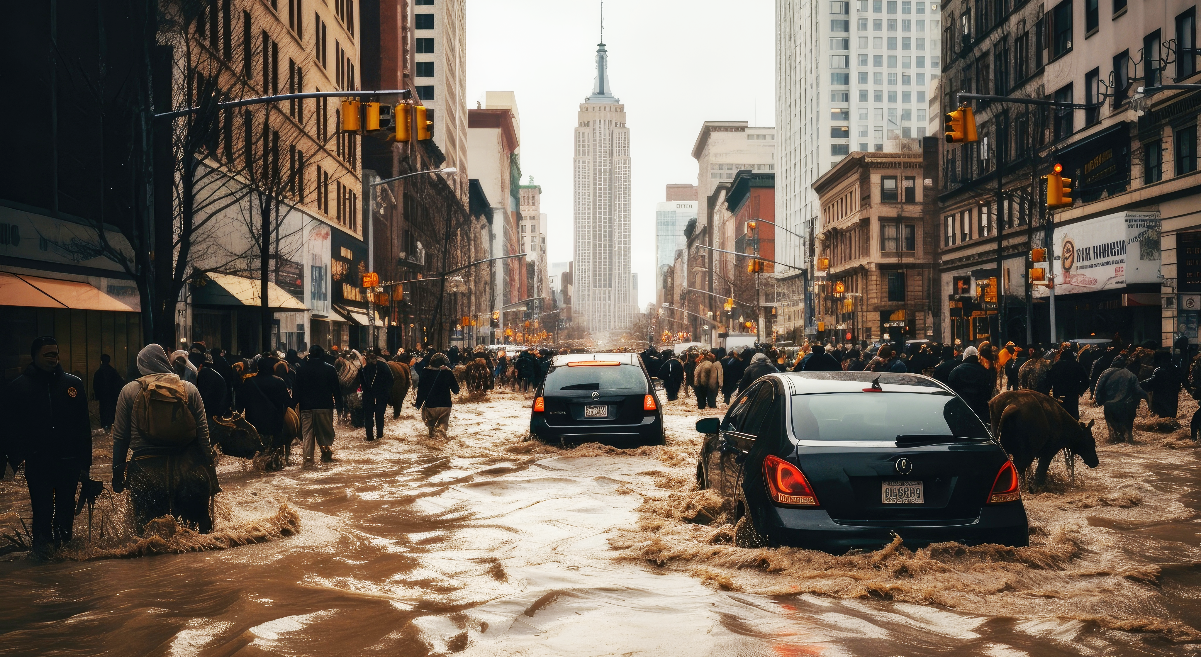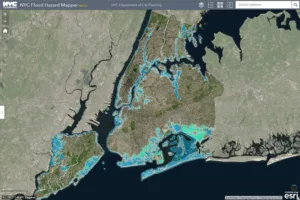The New York Flood of 2023: What Really Happened?
Unprecedented Flooding Strikes New York City
New York City found itself under siege by historic flooding on September 29, 2023. The primary culprit? The remnants of Tropical Storm Ophelia. These remnants deluged the city with rainfall, ranging from 4 to 6 inches in most areas, but a staggering 8.05 inches at JFK International Airport. The city’s unique characteristics, often referred to as the “concrete jungle,” exacerbated the flooding due to its impervious surfaces, hindering water absorption. Additionally, various climate change factors played a pivotal role, including warmer ocean waters, increased atmospheric blocking patterns, and a global uptick in severe precipitation events.
New York Flood Insurance: A Necessity Amidst the Deluge
Understanding the Hazard and the Necessity for New York Flood Insurance:
Flooding poses a significant threat to the United States, particularly in densely populated areas like New York City. This peril engulfs areas that are typically dry, and the city’s diverse construction and high population density magnify its impact. New York City experiences four distinct flood types, underscoring the importance of New York Flood Insurance for property owners, as history has repeatedly demonstrated.
Assessing the Risk with New York Flood Insurance in Mind:
New York City’s vulnerability to flooding varies from neighborhood to neighborhood, influenced by factors such as flood type and population density. New York Flood Insurance serves as a crucial financial shield against the wide-ranging consequences of flooding, ensuring that the costs associated with physical, economic, and environmental damages are mitigated.
Strategizing Management of Risk through New York Flood Insurance:
Recognizing the impossibility of preventing all flooding, New York City has shifted its focus towards raising awareness and reducing vulnerability, especially in flood-prone areas. This strategic shift involves implementing defensive measures and enhancing stormwater management. The inclusion of New York Flood Insurance provides an additional layer of protection, guaranteeing recovery and reconstruction when other strategies may fall short.
Post-Disaster Management and New York Flood Insurance:
In the wake of Hurricane Sandy, New York City developed a comprehensive coastal protection plan that encompasses both immediate and long-term strategies. The Mayor’s Office of Recovery and Resiliency was established to implement this plan, with New York Flood Insurance being a crucial component. It acts as a safeguard against the financial implications of disasters and ensures a secure future for all city residents.
The Impact: Where Did New York City Flood?
Catastrophic downpours engulfed New York on that fateful day, leading to the declaration of states of emergency across New York City, Long Island, and the Hudson Valley. The extensive flooding wreaked havoc on subway stations, roadways, and even disrupted operations at LaGuardia Airport. JFK Airport bore the brunt of the storm, recording over 8 inches of rainfall, while Brooklyn reported more than 7 inches, leading to severe disruptions in Metro-North and several subway services.
Vulnerable Areas: Mapping the Flood-Prone Zones
Lower Manhattan, including iconic areas like the South Street Seaport and Tribeca, faces significant logistical and safety challenges due to its vulnerability to flooding. Striking a balance between the cultural and financial significance of these areas and the reality of their geographical susceptibility is paramount. A robust planning approach that combines infrastructure improvements and community-based initiatives becomes critical to safeguarding the well-being of these vital Manhattan neighborhoods.
A Pattern of Peril: Recent Flood Events
Since 2020, New York City has weathered a series of destructive storms, each exposing its growing vulnerability to extreme weather events. These include Tropical Storm Fay in 2020, Tropical Storm Isaias in August 2020, Tropical Storm Henri in August 2021, the remnants of Hurricane Ida in September 2021, Winter Storm Elliot in December 2022, and most recently, the persistent rains from Tropical Storm Ophelia in September 2023.
Dispelling Assumptions: Why New York Flood Insurance is Essential
Assumption 1: Temporary Relocation is Enough
Choosing to relocate during flood warnings does not protect properties and possessions left behind. Conversely, flood insurance provides financial coverage for potential damage to your property and belongings even in your absence.
Assumption 2: Physical Barriers Are Sufficient
Utilizing sandbags might avert minor flooding but doesn’t ensure recovery from significant damage during major flood events. Flood insurance covers not only preventive measures but also reparations and replacements afterward.
Assumption 3: Federal Aid Will Save the Day
Relying on federal aid can be risky due to its limitations and conditions. Flood insurance ensures your property is financially safeguarded even when federal aid is either inadequate or inaccessible.
Assumption 4: Home Elevation is the Ultimate Solution
Elevating homes might reduce damages but does not secure personal belongings inside and might not fully protect the structure during severe floods. Flood insurance extends protection to both structural elements and personal belongings.
Assumption 5: Waterproofing Guarantees Safety
Waterproofing provides some protection but isn’t foolproof against extreme flooding. On the other hand, flood insurance provides a broader financial shield, aiding in both immediate damage control and managing financial repercussions after a severe flood.
Secure the Future with Hotaling Insurance Services
Opting for Hotaling Insurance Services reflects a strategic commitment to safeguarding against unforeseen challenges, especially underscored by recent flood scenarios.




